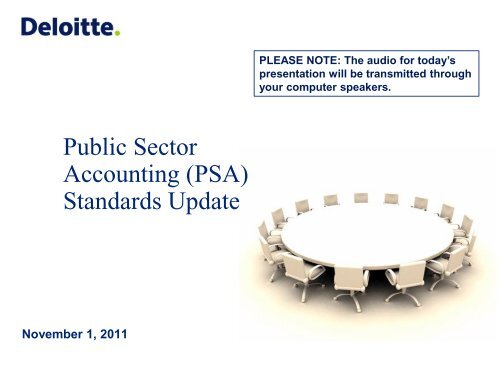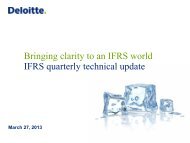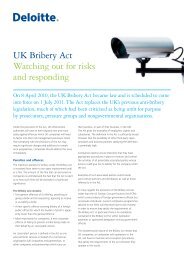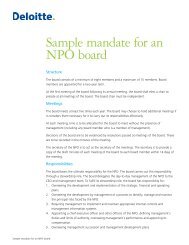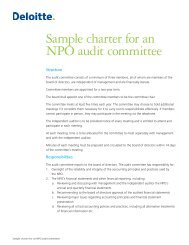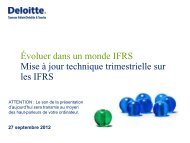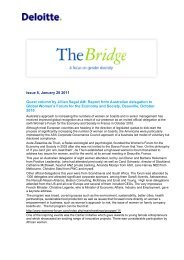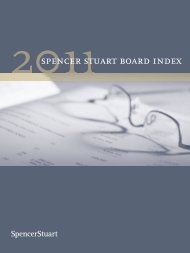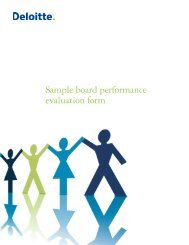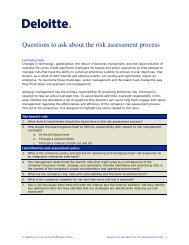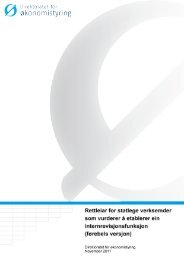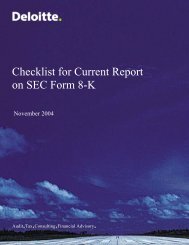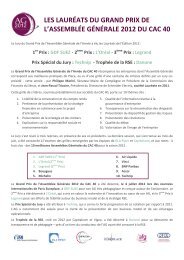Government Transfers - Deloitte
Government Transfers - Deloitte
Government Transfers - Deloitte
Create successful ePaper yourself
Turn your PDF publications into a flip-book with our unique Google optimized e-Paper software.
PLEASE NOTE: The audio for today’s<br />
presentation will be transmitted through<br />
your computer speakers.<br />
Public Sector<br />
Accounting (PSA)<br />
Standards Update<br />
November 1, 2011
Agenda<br />
• New Public Sector Accounting (PSA) Standards<br />
• Public Sector Accounting Board (PSAB) Projects<br />
• Related Party Transactions<br />
• Conceptual Framework<br />
• Financial Instruments<br />
• <strong>Government</strong> <strong>Transfers</strong><br />
• Transition to PSA Standards
Polling Question 1<br />
What is your current use of PSA Standards<br />
1. I currently prepare PSAB financial statements<br />
2. I will be preparing PSAB financial statements<br />
(with NPO standards)<br />
3. I will be preparing PSAB financial statements<br />
(without NPO standards)<br />
4. I am an auditor of PSAB financial statements<br />
5. None of the above apply to me (or I don’t<br />
know)
New Public Sector<br />
Accounting (PSA)<br />
Standards
New PSA Standards<br />
Topic<br />
Financial Statement Presentation,<br />
Amendments to Section PS 1201<br />
Foreign Currency Translation,<br />
Section PS 2601<br />
Financial Instruments,<br />
Section PS 3450<br />
<strong>Government</strong> <strong>Transfers</strong>, revised<br />
Section PS 3410<br />
<strong>Government</strong>-<br />
Effective Date<br />
GNFPOs / OGOs<br />
Effective Date<br />
April 1, 2015 April 1, 2012<br />
April 1, 2015 April 1, 2012<br />
April 1, 2015 April 1, 2012<br />
April, 1, 2012 April 1, 2012<br />
(N/A for GNFPOs<br />
applying 4200 series)<br />
Tax Revenue,<br />
Section PS 3510<br />
Liability for Contaminated Sites,<br />
Section PS 3260<br />
April 1, 2012<br />
April 1, 2014<br />
N/A
Public Sector<br />
Accounting Board<br />
(PSAB) Projects
PSAB projects<br />
Amalgamations and Restructurings<br />
Amendments arising from Financial Instruments<br />
Appropriations<br />
Assets<br />
Completeness of GAAP for <strong>Government</strong> Organizations<br />
Concepts Underlying Financial Performance<br />
PSA Handbook Terminology<br />
Related Party Transactions<br />
Revenue<br />
AcSB/PSAB Joint Not-for-Profit Task Force
Related party<br />
transactions
Related Party Transactions (RPTs)–<br />
definitions and disclosure<br />
Invitation to<br />
comment<br />
• No current guidance on accounting for RPTs<br />
• Scope – disclosure of RPTs in general<br />
purpose f/s<br />
• Comments due November 14, 2011<br />
Preliminary<br />
views -<br />
definitions<br />
Preliminary<br />
views -<br />
disclosure<br />
• Controlled entities<br />
• Entities under common control<br />
• Shared control<br />
• Key management personnel and close family<br />
• Nature of relationship<br />
• Description of transaction<br />
• Amounts recognized in f/s and outstanding<br />
balances<br />
• Basis of measurement
Related party transactions –<br />
recognition and measurement<br />
• Issues Paper released October 5, 2011<br />
Should a<br />
standard on<br />
related party<br />
transactions<br />
include guidance<br />
on recognition<br />
and<br />
measurement<br />
Transactions reported at value<br />
determined by government<br />
policy or related parties<br />
(unless guidance exists in a<br />
current standard)<br />
OR<br />
Measurement standards<br />
similar to RELATED PARTY<br />
TRANSACTIONS, Section<br />
3840 of the CICA Handbook –<br />
Accounting<br />
Comments<br />
due<br />
November<br />
14, 2011
Conceptual framework
What is a conceptual framework<br />
• coherent set of interrelated objectives and fundamentals<br />
• leads to consistent standards<br />
• prescribes the nature, function and limits of financial<br />
accounting and reporting<br />
• The conceptual framework in the PSA Handbook<br />
sets out the concepts that underlie the<br />
preparation and presentation of financial<br />
statements for governments and<br />
government organizations that<br />
apply the PSA Handbook.
Conceptual Framework<br />
Why Revising<br />
Focus of Project<br />
•Primarily a response to<br />
concerns raised by senior<br />
government on the impact of<br />
recently issued standards on<br />
measurement of financial<br />
performance:<br />
•Financial instruments<br />
•<strong>Government</strong> transfers<br />
•Review concepts underlying<br />
financial performance<br />
including:<br />
•Characteristics of public<br />
sector entities<br />
•Users and user needs<br />
•Elements of financial<br />
statements<br />
•Recognition and<br />
measurement
Conceptual Framework – preliminary views<br />
Will not revisit need for accrual accounting<br />
Will maintain current historical cost-based mixed measurement<br />
model<br />
Financial capital maintenance in financial terms<br />
Maintain crucial actual to budget comparison<br />
Framework will continue to focus only on financial statements
Key characteristics of public sector<br />
entities<br />
Public<br />
accountability<br />
Multiple<br />
objectives<br />
Rights, powers<br />
and<br />
responsibilities<br />
Lack of equity<br />
ownership<br />
Operating and<br />
financial<br />
frameworks set by<br />
legislation<br />
Importance of the<br />
budget<br />
Governance<br />
structures<br />
Nature of<br />
resources<br />
Non-exchange<br />
transactions
Conceptual Framework Project –<br />
anticipated timeline<br />
PSAB<br />
approved a<br />
project<br />
proposal<br />
Consultation<br />
Paper #1<br />
issued<br />
Statement<br />
of<br />
Principles<br />
approved<br />
Final<br />
Handbook<br />
Section<br />
expected<br />
to be<br />
approved<br />
December<br />
2010<br />
August 2011<br />
December<br />
2012<br />
December<br />
2014<br />
June 2011<br />
April 2012<br />
December<br />
2013<br />
PSAB<br />
received an<br />
update on<br />
the<br />
progress,<br />
proposed<br />
approach<br />
and<br />
timeline of<br />
the project<br />
Consultation<br />
Paper #2<br />
expected to<br />
be issued<br />
Exposure<br />
Draft<br />
expected<br />
to be<br />
approved
Financial instruments
What is a financial instrument<br />
Definition<br />
• contractual arrangement between two or more parties<br />
• gives rise to financial assets of one entity and financial liabilities or<br />
equity instruments of another entity<br />
Excluded<br />
• does not apply to transactions that are not contractual in their<br />
nature, such as taxes, grants and transfers<br />
Examples<br />
• accounts receivable and payable<br />
• loans receivable and payable<br />
• debt instruments<br />
• equity instruments<br />
• derivatives
Derivatives and Embedded Derivatives<br />
Derivatives<br />
•Characteristics:<br />
•Value changes with<br />
underlying variable<br />
•Requires little or no initial<br />
net investment<br />
•Settled at a future date<br />
•Examples:<br />
•Interest rate swaps<br />
•Forward contracts<br />
•Cross currency swaps<br />
•Written options<br />
•Purchased options<br />
Embedded<br />
Derivatives<br />
• Component within contract<br />
• Accounted for separately if:<br />
•Not closely related to host<br />
contract<br />
•Would meet the definition of<br />
a derivative<br />
•Host contract is not<br />
accounted for at fair value<br />
•Possible examples:<br />
•Contract denominated in<br />
foreign currency<br />
•Contract pricing linked to<br />
index
Changes to PSA Standards<br />
Recognition and Measurement<br />
“Old” PSA Standards<br />
Temporary investments,<br />
portfolio investments,<br />
accounts receivable–<br />
carrying value = cost, unless<br />
market value is below<br />
carrying value<br />
Limited guidance on<br />
derivatives (foreign currency<br />
guidance)<br />
“New” PSA Standard<br />
Equity instruments (portfolio investments)<br />
quoted in an active market – fair value<br />
Most derivatives (and certain embedded<br />
derivatives) – fair value<br />
All other non-derivative financial instruments –<br />
cost or amortized cost (effective interest<br />
method)<br />
Option to record financial instruments at fair<br />
value in certain circumstances<br />
New statement of remeasurment gains and<br />
losses
Foreign currency translation<br />
Unrealized gains and losses<br />
“Old” PSA Standards<br />
Gains and losses on translation are<br />
deferred and amortized to<br />
revenue/expense over the remaining<br />
term of the monetary item<br />
“New” PSA Standards<br />
All monetary assets, liabilities and<br />
non-monetary assets accounted for<br />
at fair value are adjusted to the<br />
period end exchange rate.<br />
Prior to settlement, exchange gains<br />
and losses will be recognized in a<br />
statement of re-measurement gains<br />
and losses (outside the statement of<br />
operations).
Foreign currency translation<br />
Hedging Relationships<br />
“Old” PSA Standards<br />
“New” PSA Standards<br />
Focus = hedging foreign currency risk<br />
No guidance on hedging anticipated<br />
transactions.<br />
There is no provision for hedge<br />
accounting.<br />
Limited guidance on documentation,<br />
evaluating effectiveness, and accounting<br />
for hedging relationships.
Effective interest method<br />
• The effective interest method discounts the estimated future<br />
cash payments or receipts throughout the life of a financial<br />
instrument.<br />
• Illustrative example: A public sector entity invests in a strip<br />
bond that pays $5,000,000 upon maturity in five years. Its<br />
purchase price is $3,917,500, which provides an effective<br />
yield to maturity of 5 percent. An investor in this type of<br />
security receives the $5,000,000 face value of the bond on<br />
maturity.
Effective interest method<br />
Year<br />
Strip<br />
bond<br />
0 3,917,500<br />
Interest<br />
Income<br />
Straight-line<br />
Yield<br />
Interest Income<br />
Effective<br />
interest method<br />
Yield<br />
Interest<br />
Income<br />
(Decrease)<br />
increase<br />
1 4,113,512 216,500 5.53% 196,012 5.00% (20,488)<br />
2 4,319,188 216,500 5.26% 205,676 5.00% (10,824)<br />
3 4,535,147 216,500 5.01% 215,959 5.00% (541)<br />
4 4,761,905 216,500 4.77% 226,758 5.00% 10,258<br />
5 5,000,000 216,500 4.55% 238,095 5.00% 21,595<br />
Total – interest<br />
income<br />
$1,082,500 $1,082,500
Statement of Remeasurement Gains and Losses<br />
• New statement of measurement gains and losses, reports:<br />
– unrealized gains and losses associated with financial instruments<br />
measured at fair value;<br />
– foreign exchange gains and losses on foreign denominated items<br />
carried at amortized cost;<br />
– amounts reclassified to the statement of operations upon<br />
derecognition or settlement; and<br />
– other comprehensive income reported when a government includes<br />
the results of government business enterprises and government<br />
business partnerships in the government’s summary financial<br />
statements.<br />
– Impairment losses: recorded directly in Statement of<br />
Operations
Financial instruments – fair value hierarchy<br />
1<br />
2<br />
3<br />
• Quoted prices in an active market for<br />
identical assets or liabilities<br />
• Inputs (other than quoted prices) that are<br />
observable, either directly or indirectly<br />
• Inputs that are not based on observable<br />
market data
Financial instruments – risk<br />
disclosures<br />
Market<br />
risk<br />
• Currency risk<br />
• Interest rate risk<br />
• Other price risk<br />
Risk<br />
Disclosures<br />
Credit<br />
risk<br />
Liquidity<br />
risk<br />
For each risk, an entity<br />
should discuss its exposure<br />
to risk, how they arise, and<br />
its objectives, policies and<br />
processes for managing the<br />
risks and the methods used<br />
to measure the risk.
Polling Question 2<br />
What is your level of experience with respect to<br />
financial instruments<br />
1. I have in-depth experience with the accounting<br />
standards related to financial instruments<br />
2. I have limited experience with the accounting<br />
standards related to financial instruments<br />
3. I have no experience with the accounting<br />
standards related to financial instruments<br />
4. What is a financial instrument
<strong>Government</strong> transfers
<strong>Government</strong> <strong>Transfers</strong><br />
• Complexity and accountability of government transfer<br />
programs have significantly increased<br />
• Increased requirements over financial management of<br />
transfer payments<br />
• PSAB issued the initial standard on government transfers in<br />
1990 when governments followed a modified accrual<br />
accounting basis.<br />
• PSAB undertook extensive activities to establish a new<br />
standard for government transfers to reflect the current<br />
reality.
<strong>Government</strong> <strong>Transfers</strong>, PS 3410 - New<br />
standard<br />
Standard sought to clarify:<br />
The<br />
recognition of<br />
multi-year<br />
funding to<br />
outside<br />
organizations<br />
Nature and<br />
level of<br />
authorization<br />
required for<br />
recognition of<br />
transfer<br />
Whether<br />
transfer terms<br />
& conditions<br />
affect timing<br />
of recognition<br />
by recipients<br />
& transferring<br />
government<br />
Whether the<br />
nature of the<br />
transfer<br />
affects the<br />
accounting<br />
(e.g. capital<br />
or operating)
<strong>Government</strong> <strong>Transfers</strong>, PS 3410 - New<br />
standard<br />
PS 3410,<br />
<strong>Government</strong><br />
<strong>Transfers</strong><br />
PS 3410<br />
applies to:<br />
• Applicable for fiscal years beginning on or after<br />
April 1, 2012<br />
• Early adoption encouraged<br />
• May be applied retroactively or prospectively<br />
• All levels of government<br />
• <strong>Government</strong> organizations who apply PSA<br />
standards<br />
• <strong>Government</strong> not-for-profit organizations who elect<br />
apply PSA standards without section 4200
What is a government transfer<br />
Transferring government<br />
does not :<br />
receive any goods or services<br />
directly in return, as would<br />
occur in a purchase / sale or<br />
other exchange transaction<br />
Transferring<br />
<strong>Government</strong><br />
Recipient<br />
expect to be repaid in<br />
the future, as would be<br />
expected in a loan<br />
expect a direct financial<br />
return, as would be<br />
expected in an<br />
investment<br />
monetary<br />
assets or<br />
tangible<br />
capital<br />
assets<br />
Individual,<br />
organization<br />
or another<br />
government
<strong>Government</strong> transfers – exclusions<br />
<strong>Transfers</strong> made through the tax system that are authorized under tax legislation<br />
Grants in lieu of taxes<br />
Settlements of lawsuits or other types of legal compensation provided by public<br />
sector entities<br />
CPP/QPP payments<br />
<strong>Transfers</strong> of non-monetary assets other than tangible capital assets<br />
(e.g. natural resources rights, equity investments, works or art, historical treasures)<br />
Taxes or other money collected by one government on behalf of another<br />
government or organization<br />
Flow-through arrangements where a government agrees to act merely as an<br />
intermediary to administer funds on behalf of another party
<strong>Government</strong> transfers- transferring<br />
government<br />
• A government transfer should be recognized by a<br />
transferring government as an expense in the period the<br />
transfer is authorized and all eligibility criteria have been<br />
met by the recipient.<br />
• No pre-payments or financial assets are recognized by the<br />
transferring government.<br />
• <strong>Government</strong> transfers now include transfers of tangible<br />
capital assets
<strong>Government</strong> transfers- transferring<br />
government<br />
• Eligibility criteria considerations:<br />
– Some transfer programs may require recipients to apply<br />
and meet eligibility criteria only once.<br />
– Other programs may require periodic application as well<br />
as evidence of ongoing eligibility over the periods<br />
funded.<br />
– The nature and extent of eligibility criteria may have an<br />
impact on the extent of a transferring government's liability<br />
under a transfer program at the financial statement date.
Authorization<br />
Expanded guidance and clarification provided<br />
Generally the exercise of authority (final approval) by the financial statement date<br />
required<br />
New standard allows for an earlier point of recognition based the concept of<br />
“demonstrable commitment” at the financial statement date with final approval in the<br />
stub period<br />
Reference to constructive obligation in the PS3200<br />
<strong>Government</strong> has “loss of discretion” to avoid proceeding with the transfer<br />
Earlier point of recognition only applicable to transferring government
<strong>Government</strong> transfers - recipients<br />
Eligibility<br />
criteria<br />
• describe who<br />
a recipient<br />
must be or<br />
what it must<br />
do in order to<br />
be able to<br />
get a<br />
government<br />
transfer<br />
• must be met<br />
before the<br />
transfer<br />
occurs<br />
Stipulations<br />
• describe how<br />
a recipient<br />
must use<br />
transferred<br />
resources or<br />
the actions it<br />
must perform<br />
in order to<br />
keep the<br />
transfer<br />
• met after the<br />
transfer is<br />
provided<br />
Recognition<br />
• Stipulations<br />
do not affect<br />
the timing of<br />
an expense<br />
of a<br />
transferring<br />
government<br />
• Stipulations<br />
can affect<br />
revenue<br />
recognition<br />
timing by the<br />
recipient
<strong>Government</strong> transfers - recipients<br />
Situation<br />
Transfer without eligibility criteria or<br />
stipulations<br />
Transfer with eligibility criteria but<br />
without stipulations<br />
With or without eligibility criteria but<br />
with stipulations<br />
Accounting requirements<br />
Recognized as revenue when the<br />
transfer is authorized<br />
Recognize as revenue when<br />
authorized and eligibility criteria<br />
met<br />
Recognize as revenue when<br />
authorized and eligibility criteria met,<br />
except when and to extent the<br />
transfer gives rise to an obligation<br />
that meets the definition of a liability<br />
for the recipient in accordance with<br />
liabilities (PS 3200)
<strong>Government</strong> transfers- disclosure<br />
Financial statements should<br />
disclose<br />
major kinds of transfers recognized<br />
in the accounting period<br />
information about the nature and<br />
terms of liabilities, if any, arising<br />
from government transfers received
Conclusions<br />
New standard<br />
clarifies …<br />
• Impact of<br />
stipulations on<br />
revenue<br />
recognition<br />
• Recognition of<br />
assets and<br />
liabilities<br />
• Authorization<br />
(transferor and<br />
recipient)<br />
Considerations<br />
• Granting<br />
processes &<br />
related<br />
documentation<br />
• Internal control<br />
implications<br />
• Detailed analysis<br />
required on a case<br />
by case basis<br />
• Quarterly reporting<br />
impacts
Polling Question 3<br />
What stage are you at with respect to<br />
transitioning to PSA Standards<br />
1. My government organization has completed its<br />
PSAB transition planning<br />
2. My government organization is in the process of<br />
completing its PSAB transition planning<br />
3. My government organization has not started its<br />
PSAB transition planning<br />
4. My organization is a government or a government<br />
organization already following PSAB<br />
5. Not applicable
Transition to PSA<br />
standards
Not-for-profit and Public Sector - changes in Accounting Frameworks<br />
Type of Organization Accounting Framework First reporting period – year<br />
beginning on or after:<br />
<strong>Government</strong> PSA Standards N/A<br />
P<br />
S<br />
A<br />
B<br />
<strong>Government</strong> Business<br />
Enterprise (GBE)<br />
<strong>Government</strong> Not-for-Profit<br />
Organization (GNFPO)<br />
IFRSs<br />
Choice of:<br />
i. Existing NPO standards<br />
(4400 series with minor<br />
modifications) + PSA<br />
Standards as underlying<br />
framework, or<br />
ii. PSA Standards (without<br />
NPO standards)<br />
January 1, 2011 (unless<br />
organization qualifies for 1 year<br />
deferral)<br />
January 1, 2012<br />
Other <strong>Government</strong><br />
Organization (OGO)<br />
PSA Standards or IFRSs based<br />
on assessment of users’ needs<br />
January 1, 2011<br />
A<br />
c<br />
S<br />
B<br />
Not-for-Profit Organization<br />
(not controlled by<br />
government) (NPO)<br />
Choice of:<br />
i. Existing NPO standards<br />
(4400 series with minor<br />
modifications) + Accounting<br />
Standards for Private<br />
Enterprises (ASPE) as<br />
underlying framework, or<br />
ii. IFRSs<br />
January 1, 2012
Timeline – first time adoption by<br />
GNFPOs with a March year end<br />
April 1, 2011:<br />
Date of transition to new Accounting<br />
Framework<br />
Opening statement of financial position date.<br />
Beginning of first year of full comparative<br />
financial statements in accordance with new<br />
Accounting Framework.<br />
April 1, 2012:<br />
Date of conversion<br />
External reporting commences<br />
under to new Accounting<br />
Framework with restated<br />
comparative financial statements.<br />
April 1, 2011 March 31, 2012 April 1, 2012 March 31, 2013<br />
March 31, 2012:<br />
Last audited financial<br />
statements prepared in<br />
accordance with Canadian<br />
GAAP.<br />
March 31, 2013:<br />
First audited financial statements under<br />
new Accounting Framework with<br />
restated comparative financial<br />
statements.
What are the impacts on the date of transition<br />
Retroactive<br />
application with<br />
restatement of<br />
prior periods,<br />
subject to the<br />
elective<br />
exemptions<br />
provided.<br />
Recognize and<br />
measure<br />
assets and<br />
liabilities in<br />
accordance with<br />
the new<br />
accounting<br />
framework as of<br />
the date of<br />
transition<br />
Understand<br />
exceptions &<br />
determine<br />
which<br />
elective<br />
exemptions<br />
to apply<br />
Disclosure<br />
requirements
Financial Instruments – transition<br />
considerations<br />
PS 3450 -<br />
transition<br />
guidance<br />
<strong>Government</strong><br />
organizations<br />
– early<br />
adoption<br />
Comparative<br />
figures
Financial instruments – PS 3450<br />
transition guidance<br />
<strong>Government</strong><br />
organizations<br />
<strong>Government</strong>s<br />
<strong>Government</strong><br />
organizations - apply<br />
PS 3450 in the<br />
same period PSA<br />
Standards adopted<br />
for the first time<br />
[PS 3450.100]<br />
Applies to fiscal<br />
years beginning<br />
on or after<br />
April 1, 2012.<br />
Retroactive<br />
application<br />
is<br />
prohibited.<br />
Earlier<br />
adoption is<br />
permitted.<br />
Applies to fiscal<br />
years beginning<br />
on or after<br />
April 1, 2015.<br />
Retroactive<br />
application<br />
is<br />
prohibited.<br />
Earlier<br />
adoption is<br />
permitted.<br />
Comparative<br />
amounts<br />
presented<br />
are not<br />
adjusted.<br />
Retroactive<br />
application<br />
is<br />
prohibited.
Frequently asked questions –<br />
financial instruments transition<br />
What happens to<br />
accumulated<br />
other<br />
comprehensive<br />
income for<br />
entities<br />
transitioning to<br />
PSA Standards<br />
Should a<br />
government<br />
organization<br />
consider early<br />
adoption of PS<br />
3450 and PS<br />
2601<br />
Should government<br />
organizations<br />
transitioning to PSA<br />
Standards for the<br />
first time restate<br />
their comparative<br />
figures for PS 3450<br />
and PS 2601
<strong>Government</strong> organizations – early<br />
adoption of PS3 450 & PS 2601<br />
• The effective date of PS 3450 and PS 2601 is after the<br />
date of transition to the PSA Handbook for government<br />
organizations and for some GNFPOs.<br />
• <strong>Government</strong> organizations and GNFPOs may wish to early<br />
adopt these new standards on transition to the PSA<br />
Handbook<br />
– This avoids having to change accounting policies in these<br />
areas twice within a few years.
Restatement of comparative figures<br />
• Context: <strong>Government</strong> organizations that adopt Section PS<br />
3450 and Section 2601 in their first PSA compliant financial<br />
statements<br />
• Applicable timeline:<br />
– government organizations - beginning of the fiscal year<br />
that begins on or after January 1, 2011<br />
– government not-for-profit organizations - beginning of<br />
the fiscal year that begins on or after January 1, 2012<br />
• The balances in the opening statement of financial position<br />
and the comparative figures in their first PSA financial<br />
statements will be based on the accounting policies they<br />
follow for Financial Instruments and Foreign Currency<br />
Translation prior to their transition to the PSA Handbook.
Accumulated other comprehensive<br />
income on PSAB transition<br />
• Context: An entity that previously had financial instruments<br />
carried at fair value<br />
– Examples:<br />
• investments classified as available for sale<br />
• derivatives measured at fair value<br />
• Any adjustment of the previous carrying amount is<br />
recognized as an adjustment to the accumulated<br />
remeasurement gains and losses at the beginning of the<br />
fiscal year in which PS 3450 is applied.
First time adoption – PS 2125 optional<br />
exemptions<br />
retirement<br />
and postemployment<br />
benefits<br />
business<br />
combinations<br />
government<br />
business<br />
partnerships<br />
tangible<br />
capital asset<br />
impairment<br />
investments<br />
in<br />
government<br />
business<br />
enterprises
Lessons learned<br />
Understand your organization’s control<br />
assessment & classification<br />
Start early - identify the differences between<br />
existing Canadian GAAP and PSA standards<br />
Expect change - nothing is straightforward
Lessons learned (continued)<br />
Obtain expert advice<br />
Develop position papers –assessment of complex accounting<br />
issues<br />
Prepare a PSA compliant opening statement of financial position,<br />
including PSA disclosures.<br />
Keep your Audit Committee, Board and other stakeholders up to<br />
date
Polling Question 4<br />
How comfortable are you with your level of<br />
knowledge with PSA Standards<br />
1. I have been using PSA standards for a number<br />
of years and I am comfortable with applying PSA<br />
standards.<br />
2. I have been using PSA standards for a number<br />
of years but find it difficult to keep up to date.<br />
3. I know something about PSA standards, but<br />
require more training.<br />
4. PSA Standards are completely new to me.
Questions<br />
Paula Jesty<br />
Partner<br />
pjesty@deloitte.ca<br />
Cindy Veinot<br />
Partner<br />
cveinot@deloitte.ca<br />
Pina Colavecchia<br />
Senior Manager<br />
pcolavecchia@deloitte.ca


